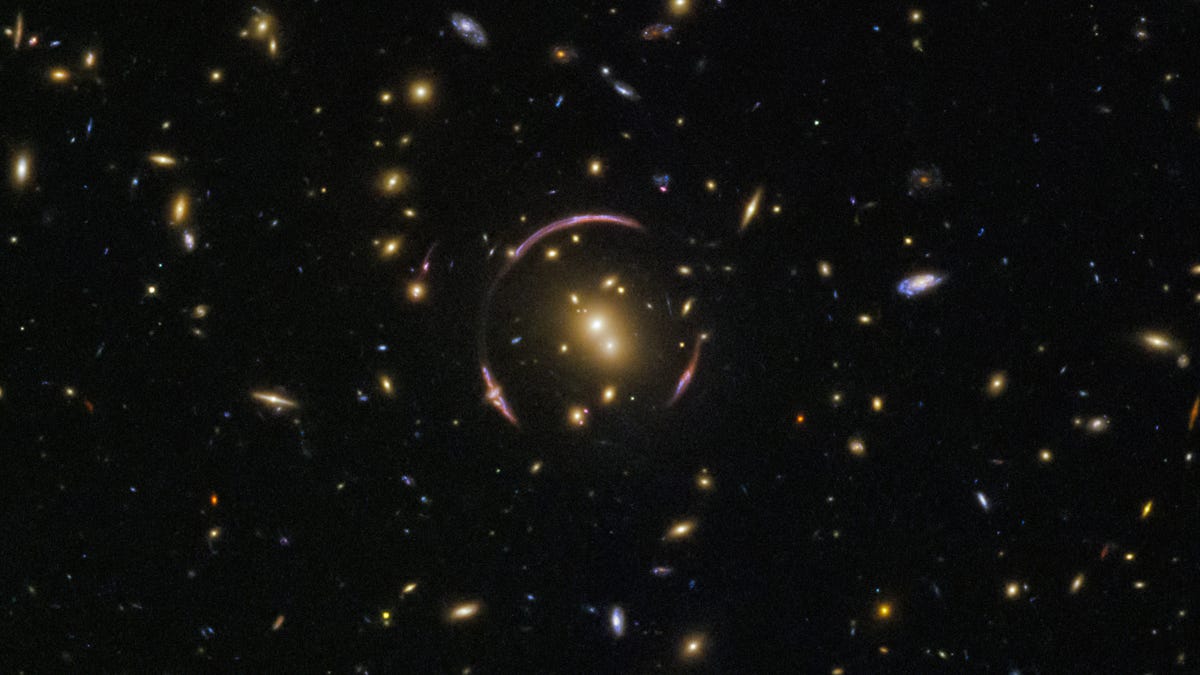In April 2023, the University of Hong Kong published a groundbreaking paper revealing that dark matter exhibits wave-like properties. This discovery aligns with our earlier predictions, reinforcing our belief that dark matter consists of electromagnetic (EM) waves. However, in light of the University of Hong Kong's findings, there has been a growing tendency to consider dark matter not as Weakly Interacting Massive Particles (WIMPs), but rather as another hypothetical particle, Axion. An example of this perspective shift can be found in the following report:

Astrophysicists Spot Einstein Rings That Boost Case for Axionic Dark Matter
Signatures of gravitational lensing in images of distant galaxies suggest the presence of wave-like dark matter.
 gizmodo.com
gizmodo.com
Here, we present a brief explanation as to why we maintain our view that any small, currently undiscovered, as-yet-unseen particles cannot account for dark matter. We base this argument on two distinct types of observations that challenge the notion of dark matter being composed of particles with mass.
First, dark matter particles would not fall together under their own gravity.
The first type of observation concerns the inability of particle-based dark matter to explain why it does not collapse under its own gravitational force. According to the prevailing Dark Matter theory, these particles are responsible for the unexplained gravitational effects observed in galaxies. If dark matter consisted of very small and lightweight particles with mass, it would be expected to gravitationally fall together, forming a flat disc in alignment with the shape of the galaxy. However, the actual observation contradicts this expectation, as dark matter forms a spherical halo around the galaxy. Our theory posits that the unknown gravitational effect, referred to as dark matter in mainstream science, is actually exerted by EM waves. In this scenario, the spherical shape of the gravitational field can be easily explained by the emission of EM waves or light from the galaxy, which propagates in all directions, generating a spherical gravitational field.
Second, there is no good explanation for why the brightness of visible matter is related to dark matter if dark matter is made of particles.
The second type of observation pertains to the puzzling relationship between the brightness of visible matter and dark matter if the latter were comprised of separate, invisible particles. Here are three examples of these observations:
The Tully-Fisher relation demonstrates a strong correlation between the brightness of galaxies (visible matter) and their rotational speeds, which encompasses the cumulative gravitational forces from regular matter and dark matter. Dr. Lincoln from Fermilab expresses this.
“But existing dark matter theory predicts that any random galaxy may contain larger or smaller fractions of dark matter. So, when one measures the visible mass, you could potentially be missing a huge chunk of the total mass. As a result, visible mass should be a very poor predictor of the total mass (and thereby rotational speed) of the galaxy. The galaxy's mass could be similar to that of the visible (ordinary) mass or it could be much larger.
Thus, there is no reason to expect that the visible mass should be a good predictor of the rotational speed of the galaxy. Yet it is.”
In a galaxy, the central region appears significantly brighter and gradually diminishes in brightness towards the outer regions. Additionally, dark matter exhibits a higher concentration towards the center, gradually decreasing as one moves away from it. The alignment between dark matter concentration and brightness in a galaxy cannot be explained by considering dark matter as small unseen particles.
In addition to the above observations, there is evidence indicating a correlation between dark matter density and the unresolved gamma-ray background, which further complicates the particle-based explanation of dark matter
These three observations collectively pose significant challenges for dark matter as a particle. Alternatively, if the gravitational effect arises from the gravitational force exerted by EM waves, all of these phenomena can be easily understood. Stronger EM waves result in a greater gravitational force.
Our next prediction is further comprehensive research will show that dark matter will not only exhibit wave-like behavior, but also display its effect on EM waves with varying frequencies. We are confident that these predictions will be substantiated and validated through meticulous analysis of gravitationally lensed images, particularly those obtained by the James Webb Space Telescope.
We reference the following link, which provides equations describing the gravitational force between photons or mass and photons:
https://zenodo.org/record/4541280#.ZF1g987MK5d
The following link is a paper on introduction of our new gravity theory:
Unified Field Theory for Gravity and Electromagnetism and Its Explanation for Dark Matter Observations
Dark matter is one of the most mysterious physics observations today and has puzzled the scientific community for decades. We can detect its gravitational effect but not the matter itself. After years of study and billions of dollars in spending by some of the top researchers in the world, we...
In conclusion, numerous robust cosmological observations contradict the notion of dark matter as any particle with mass. However, when viewed through the lens of EM waves exerting gravitational force, these observations align and provide compelling evidence for the existence of dark matter's gravitational effects.


